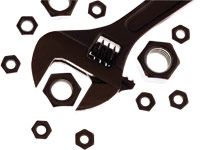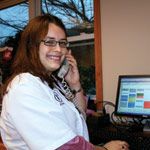Overhaul outcome: Finding the tools for success
Practice Management Overhaul winners reveal what they've learned throughout the process and how it's transformed their practice.
Sometimes fine-tuning is all it takes to turn a good practice into a great one. Other times you need to take several mechanisms apart and reconfigure them in a new way. But knowing which approach to take—and what needs to change—can be challenging when you're knee-deep in the day-to-day activities. Sometimes it takes an outside expert to show you where to start and to give you the tools to continue the repairs yourself. Enter the Veterinary Economics Practice Management Overhaul, sponsored by IDEXX Laboratories.

Our practice management experts Pamela Stevenson, CVPM, and Donna Bauman, CVPM, worked with two practices selected from more than 100 who told us about their struggles and shortcomings, their trials and tiffs, in an effort to be chosen for an intensive two-month management consultation. Were the winning practices ready to hear the consultants' feedback and, what's more, act on their numerous suggestions? Let's find out.
Northwest Animal Hospital, Omaha, Neb.
New owner gets help instilling team accountability, camaraderie.

May I help you? One of the practice's first changes made was to designate an afternoon receptionist.
It's your practice, your vision, your goals," Donna Bauman, CVPM, told Dr. Jodi Houts. "Your team should help you accomplish those goals. If they don't, it's like trying to shove a square peg into a round hole. You're not getting them in there no matter how hard you pound."
Dr. Houts purchased Northwest Animal Hospital in Omaha, Neb., in July 2009 after spending four years at the practice as an associate. The previous owner wasn't big on management or structure, she says—they had two staff meetings during her four years as an associate—so her goals for the Practice Management Overhaul were to foster better communication and tighten the organization. Bauman developed a 20-page plan aimed at changing the culture of the two-doctor small animal practice. Dr. Houts describes the plan as "tons of things to work on."

EXISTING CHALLENGES
Dr. Houts was facing some tough challenges, Bauman says. First of all, she was operating without a receptionist most afternoons. In fact, the previous owner didn't employ a receptionist at all until Dr. Houts lobbied for someone to staff the front desk at least during the morning hours. The rest of the time, team members answered the phone and handled reception duties "as needed."
Complicating this problem was the rush of discharges late in the day. "There would be nobody in the waiting room, then suddenly it would be chaos," Bauman says. "That left the doctors feeling rushed as they met with clients."
Also, the practice team wasn't meeting regularly, and disputes over uncompleted tasks were common between the morning and afternoon shifts. Despite the fact that things weren't getting done, Dr. Houts often observed team members wasting downtime, which frustrated her. "It was like you put these people in a building and shouted, 'Go!'," Bauman says. "As a new owner juggling medical and management responsibilities, Dr. Houts had a lot on her plate."
FAST FIXES, LONG-TERM GOALS
Bauman first focused on making concrete suggestions that Dr. Houts could implement at once. First of all, the practice now designates an afternoon receptionist, and the team schedules hospital and surgery discharges with doctors or technicians, depending on the nature of the case. Bauman supplied a number of forms to help with these changes, which Dr. Houts says have helped (click here to download these forms).
To fight wasted downtime, Dr. Houts has established a "to-do bucket." The bucket contains lists of the jobs that need to be done but often get ignored. Employees know that if they have spare time, they should grab a task from the bucket, "and if they don't want to do that job, they'll be sent home," Bauman says. "I understand the owner's frustration. When you look at team members wasting downtime, you see dollar signs going out the door."
Checklists have helped address problems between shifts. By clearly defining the tasks employees in each shift need to complete and check off, Bauman has hoped to stop the backbiting and instill accountability. Dr. Houts reports modest early improvement.
Bauman also suggested creating a "Good Job Wall" on which team members can post positive comments about their colleagues' work. They might observe a coworker who helped carry food to Mrs. Jones' car or capably dealt with an angry client. Dr. Houts told Bauman that the Good Job Wall was "a big hit the day they started it." It gives team members more appreciation for the work others do in the practice, which has improved teamwork and motivation. It has also moved the practice away from a "hub-and-spokes" feedback model, where all positive comments come from the owner in the hub out to the team members at the spokes.
One of Bauman's early strategies was to act as a mystery phone shopper, calling the practice pretending to be a potential client. In one of the first calls, she said she'd gotten a new puppy and wanted to know about an exam. The person who answered the phone quoted her an exam fee—and that's it. "If you say your practice is all about meeting the needs of the clients, your phone technique needs to reflect that," Bauman says. "I tell practice owners to monitor these things so they know what message team members are sending."
Dr. Houts called a staff meeting and began training sessions to address the telephone issues Bauman discovered. "There's a lot we can improve on," Dr. Houts says. "We don't always ask every question we should."
Bauman says many practices don't show improvement in mystery calls for nine or 10 months. "I told Dr. Houts she now has a plan," Bauman says. "She can take a year to implement it. It ends for me, but it doesn't have to end for her." Dr. Houts agrees. "It's definitely a work in progress," she says.
Appalachian Animal Hospital, East Ellijay, Ga.
When Kristen Lewis and her husband, Dr. Lyn Lewis, typed up consultant Pamela Stevenson's recommendations for their North Georgia practice, the bulleted list ran three single-spaced pages and numbered 56 items.

Scheduled phone time: The veterinarians at Appalachian Animal Hospital now make their own medical callbacks.
Another pair of practice owners might have thrown in the towel. But this was just the sort of challenge that Kristen and Lyn Lewis were prepared to meet—and that they'd hired their team to meet.
"One question we ask people when we're hiring is, 'Are you able to adapt to a changing environment?'" Kristen Lewis says. "At our practice we've been able to retain good employees. They're people who make things happen."
It's no surprise that the team members at Appalachian Animal Hospital in East Ellijay, Ga., are asked to be light on their feet. The practice treats cats and dogs, of course, but also gorillas, kangaroos, exotics, and an array of local wildlife. "No day," Kristen Lewis says, "is ever the same."

What's more, the surrounding community consists of two distinct groups: folks local to Appalachia and Florida retirees who've moved north so they can experience more than one season. Each group tends to approach veterinary care with different expectations.
Being geared for change meant the team implemented some of Stevenson's recommendations the day after she made them. And two months later, about 90 percent of the recommendations were in place. "We threw a lot of stuff at them at one time," says Stevenson, a certified practice manager and consultant based in Durham, N.C. "But it's been nice to work with a team as motivated as this one."
BREAKING THE BOTTLENECKS
One of Stevenson's first assignments was for the team to conduct a time study aimed at understanding client and patient flow through the hospital. The study revealed a major bottleneck: The time between when one of the five veterinarians finished with a patient and when that pet's owner left the practice was too long. Three out of four clients spent more than five minutes checking out, which created a "fishbowl syndrome" around the front desk—clients could watch every interaction between the receptionist and other pet owners while waiting their turn.
"The team reorganized to make the checkout process quicker, dedicating a quiet place for each doctor to complete the chart without interruption, and they began to manage client expectations," Stevenson says. "They had the technician who walked out with the client say something like, 'This could take five or 10 minutes. Would you like to have a seat in the waiting room and the doctor will be right out? We won't forget about you.' Some still chose to stand and watch the receptionist, but more went in to take a seat."
The study also showed that one in three clients were in the practice more than an hour per visit. Stevenson thinks one hour should be the maximum amount of time a person is asked to set aside for an outpatient appointment. Kristen Lewis says her practice built five new exam rooms last summer in anticipation of practice growth. With Stevenson's help, the team reorganized use of those rooms to get clients in and out more quickly.
The results of a second time study conducted two months later were encouraging. The practice dramatically cut the amount of time clients spent in the exam room waiting for the doctor: from 40 percent who waited more than 15 minutes to 24 percent. The percentage of clients who were in the exam room more than 20 minutes was reduced about the same amount. And the number of clients who spent more than an hour in the practice was reduced from one in three to about one in five.
While the study also showed that the practice still has some work to do in reducing client checkout times, Kristen Lewis is pleased. "I feel like we're seeing a lot better flow," she says. "Things seem to be going much better."
MAKING TIME FOR CALLBACKS
Stevenson also helped the practice tackle low client compliance with follow-up visits by suggesting that each doctor set aside a portion of the day to make medical callbacks. This strategy is known to increase recheck appointments, but unless that time is scheduled, she says, doctor callbacks will be hit-and-miss. Kristen Lewis reports success with this tactic, particularly because team members have been asked not to interrupt the veterinarians while they're making these calls.
Stevenson says that before her suggestion, medical callbacks (calls involving surgery reports, lab results, complicated cases, and so on) were made by team members—a practice she doesn't recommend. "Follow-up visits are critical, especially for eye, ear, and skin problems," she says. "In my book the veterinarian follows up with these cases until they're managed, cured, or the client says, 'I'm done.'" In addition, the team has begun urging clients to schedule follow-up appointments before they leave the practice.
The team has also adopted a key philosophical strategy: to "celebrate normals" in diagnostics. It's easy for doctors to feel cost-validated when lab results show problems, Stevenson says, but as the profession moves more toward surveillance diagnostics, "telling the client that the blood work looks great and the pet is healthy should be fun to do."
John Lofflin is Veterinary Economics' special assignments editor. Send questions and comments to ve@advanstar.com